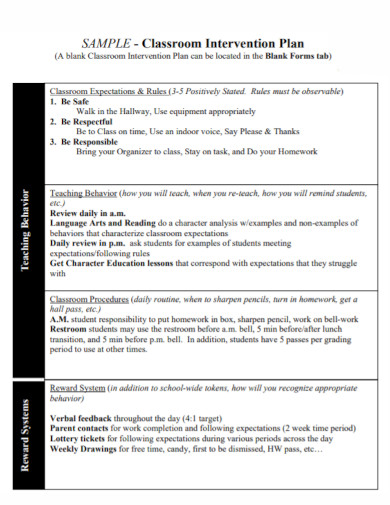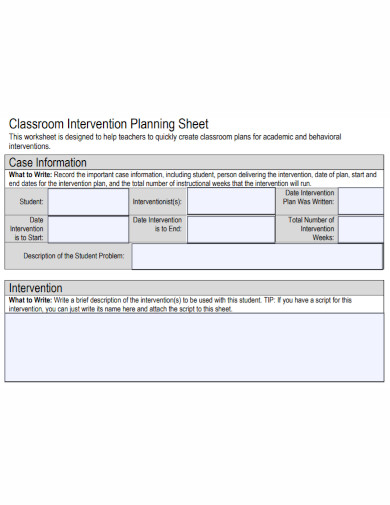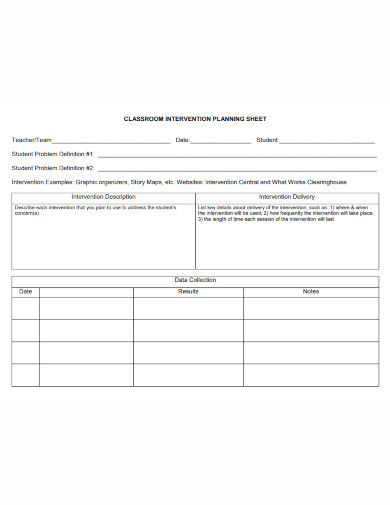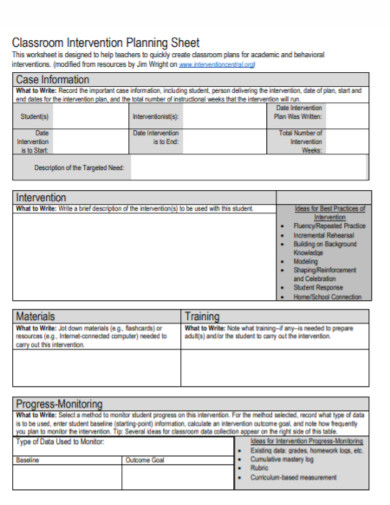Classroom Intervention Plan Examples to Download
It goes without saying teachers are often called as the second parents to their students. Especially when it comes to the utmost care for a student’s education. Teachers often go through great lengths to teach students and to leave no student behind. The simplest of actions a teacher or any individual can do should benefit not only themselves, but to the student or students as well. But what we don’t see is the intervention a teacher does inside the classroom. These kinds of interventions can be little and unseen to huge and noticeable. In addition to that, these interventions range from behavioral to educational. So here are some 3+ classroom intervention plans examples in PDF.
4+ Classroom Intervention Plan Examples
1. Classroom Behavior Intervention Plan Template
2. Classroom Intervention Plan Template
3. Classroom Intervention Plan Sheet
4. Basic Classroom Intervention Plan
5. Teachers Classroom Intervention Plan
Definition of Intervention
To define the term intervention, this means to pry, to restrain or to avert the outcome of a course especially if this process is to cause harm to an individual. To get involved in situations that may seem difficult simply to stop something from happening.
Definition of Classroom Intervention
A classroom intervention is a step by step procedure or a step by step plan that a teacher uses for her students. This procedure helps a student improve in areas that she or he is struggling with. How this is done will be discussed later in this article.
Classroom Strategies to Use
As any teacher may tell you, a good strategy is enough to keep students in check and in line. Here are some strategies that you can use. Followed by some Classroom Intervention Techniques to use.
- Emphasize behavioral management in the classroom – giving a set of rules for students to follow can actually help them know how to behave inside and outside of the classroom.
- Encourage learning – your students may sound or seem shy at first. Encouraging them to speak up and learn with you can help ease the problems.
- Model what you teach – It doesn’t only help that you teach your students the things they need to learn. It is also best if you model what you teach. If you are teaching them the value of honesty, model it. Your students, especially children are very observant, use this as a tool to help you.
- Play educational games – playing educational games can also be a good strategy to use to coax a shy student. Games that can help them with social skills, can also be used to learn something. A win-win situation.
- Work as a team with your students
Classroom Intervention Techniques
Moving on, here are some classroom intervention techniques you can use to assess your students. Find the problem and nip it from the bud.
- Clarify your objectives – make sure your objectives cater to your students, and their needs.
- Set a goal – What are you planning on doing once you have your objectives? Set a goal that fits the problem and find a way to fix it. Again, your goals must cater to the needs of your students.
- Monitor Progress – Regardless of how small the progress is, monitor everything. See if there is any difference since you started with the intervention.
- Give some feedback – Be specific with your feedback. Write everything down, be honest with your feedback as this will help you with your continuous interventions.
- Give Directions- Your directions have to fit the intervention strategy you are using for your students.
- Make a reflection- Reflect on the strategies, plans, objectives and the outcomes that have been achieved. In addition to that, you may also add the outcomes that have not been reached yet and find another way to reach it.
FAQs
Why is an intervention strategy important?
The reason for having an intervention strategy for your class is to maintain the balanced atmosphere of your class. It is also to find problems that may arise within your students, and to nip them in the bud before they get worse.
What is the difference between intervention and strategy?
Intervention means to stop the outcome of a situation or a condition. To prevent something bad from happening to someone. While a strategy is a carefully thought out plan or method.
What should I write in my feedback?
Your feedback should consist of the things you have observed from your student and the strategies if they are suitable for the student or not.
Carefully thought out strategies paired with interventions can come out as a success. The reason to have a carefully thought out intervention plan is to make sure that your interventions cater to your students.







